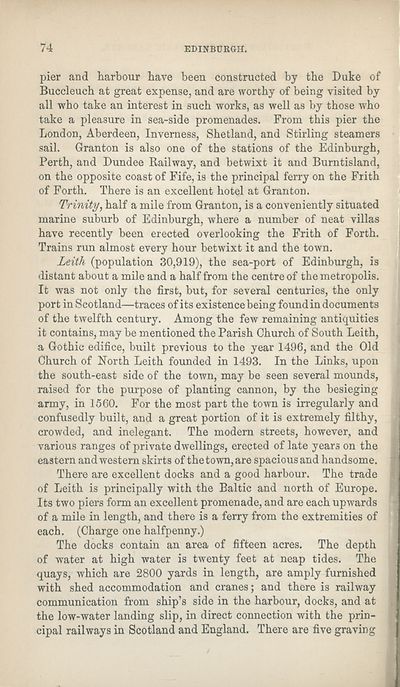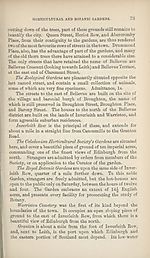Download files
Complete book:
Individual page:
Thumbnail gallery: Grid view | List view

74
EDINBURGH.
pier and harbour have been constructed by the Duke of
Buccleuch at great expense, and are worthy of being visited by
all who take an interest in such works, as well as by those who
take a pleasure in sea-side promenades. From this pier the
London, Aberdeen, Inverness, Shetland, and Stirling steamers
sail. Granton is also one of the stations of the Edinburgh,
Perth, and Dundee Railway, and betwixt it and Burntisland,
on the opposite coast of Fife, is the principal ferry on the Frith
of Forth. There is an excellent hotel at Granton.
Trinity, half a mile from Granton, is a conveniently situated
marine suburb of Edinburgh, where a number of neat villas
have recently been erected overlooking the Frith of Forth.
Trains run almost every hour betwixt it and the town.
Leith (population 30,919), the sea-port of Edinburgh, is
distant about a mile and a half from the centre of the metropolis.
It was not only the first, but, for several centuries, the only 1
port in Scotland—traces of its existence being found in documents j
of the twelfth century. Among the few remaining antiquities
it contains, may be mentioned the Parish Church of South Leith, I
a Gothic edifice, built previous to the year 1496, and the Old j
Church of North Leith founded in 1493. In the Links, upon
the south-east side of the town, may be seen several mounds, j
raised for the purpose of planting cannon, by the besieging |
army, in 1560. For the most part the town is irregularly and
confusedly built, and a great portion of it is extremely filthy,
crowded, and inelegant. The modem streets, however, and
various ranges of private dwellings, erected of late years on the
eastern and western skirts of the town, are spacious and handsome.
There are excellent docks and a good harbour. The trade
of Leith is principally with the Baltic and north of Europe.
Its two piers form an excellent promenade, and are each upwards
of a mile in length, and there is a ferry from the extremities of
each. (Charge one halfpenny.)
The docks contain an area of fifteen acres. The depth ;
of water at high water is twenty feet at neap tides. The
quays, which are 2800 yards in length, are amply furnished
with shed accommodation and cranes; and there is railway
communication from ship’s side in the harbour, docks, and at
the low-water landing slip, in direct connection with the prin¬
cipal railways in Scotland and England. There are five graving
EDINBURGH.
pier and harbour have been constructed by the Duke of
Buccleuch at great expense, and are worthy of being visited by
all who take an interest in such works, as well as by those who
take a pleasure in sea-side promenades. From this pier the
London, Aberdeen, Inverness, Shetland, and Stirling steamers
sail. Granton is also one of the stations of the Edinburgh,
Perth, and Dundee Railway, and betwixt it and Burntisland,
on the opposite coast of Fife, is the principal ferry on the Frith
of Forth. There is an excellent hotel at Granton.
Trinity, half a mile from Granton, is a conveniently situated
marine suburb of Edinburgh, where a number of neat villas
have recently been erected overlooking the Frith of Forth.
Trains run almost every hour betwixt it and the town.
Leith (population 30,919), the sea-port of Edinburgh, is
distant about a mile and a half from the centre of the metropolis.
It was not only the first, but, for several centuries, the only 1
port in Scotland—traces of its existence being found in documents j
of the twelfth century. Among the few remaining antiquities
it contains, may be mentioned the Parish Church of South Leith, I
a Gothic edifice, built previous to the year 1496, and the Old j
Church of North Leith founded in 1493. In the Links, upon
the south-east side of the town, may be seen several mounds, j
raised for the purpose of planting cannon, by the besieging |
army, in 1560. For the most part the town is irregularly and
confusedly built, and a great portion of it is extremely filthy,
crowded, and inelegant. The modem streets, however, and
various ranges of private dwellings, erected of late years on the
eastern and western skirts of the town, are spacious and handsome.
There are excellent docks and a good harbour. The trade
of Leith is principally with the Baltic and north of Europe.
Its two piers form an excellent promenade, and are each upwards
of a mile in length, and there is a ferry from the extremities of
each. (Charge one halfpenny.)
The docks contain an area of fifteen acres. The depth ;
of water at high water is twenty feet at neap tides. The
quays, which are 2800 yards in length, are amply furnished
with shed accommodation and cranes; and there is railway
communication from ship’s side in the harbour, docks, and at
the low-water landing slip, in direct connection with the prin¬
cipal railways in Scotland and England. There are five graving
Set display mode to:
![]() Universal Viewer |
Universal Viewer | ![]() Mirador |
Large image | Transcription
Mirador |
Large image | Transcription
| Antiquarian books of Scotland > Scotland/Scots > Black's picturesque tourist of Scotland > (126) |
|---|
| Permanent URL | https://digital.nls.uk/130029702 |
|---|
| Description | Thousands of printed books from the Antiquarian Books of Scotland collection which dates from 1641 to the 1980s. The collection consists of 14,800 books which were published in Scotland or have a Scottish connection, e.g. through the author, printer or owner. Subjects covered include sport, education, diseases, adventure, occupations, Jacobites, politics and religion. Among the 29 languages represented are English, Gaelic, Italian, French, Russian and Swedish. |
|---|

